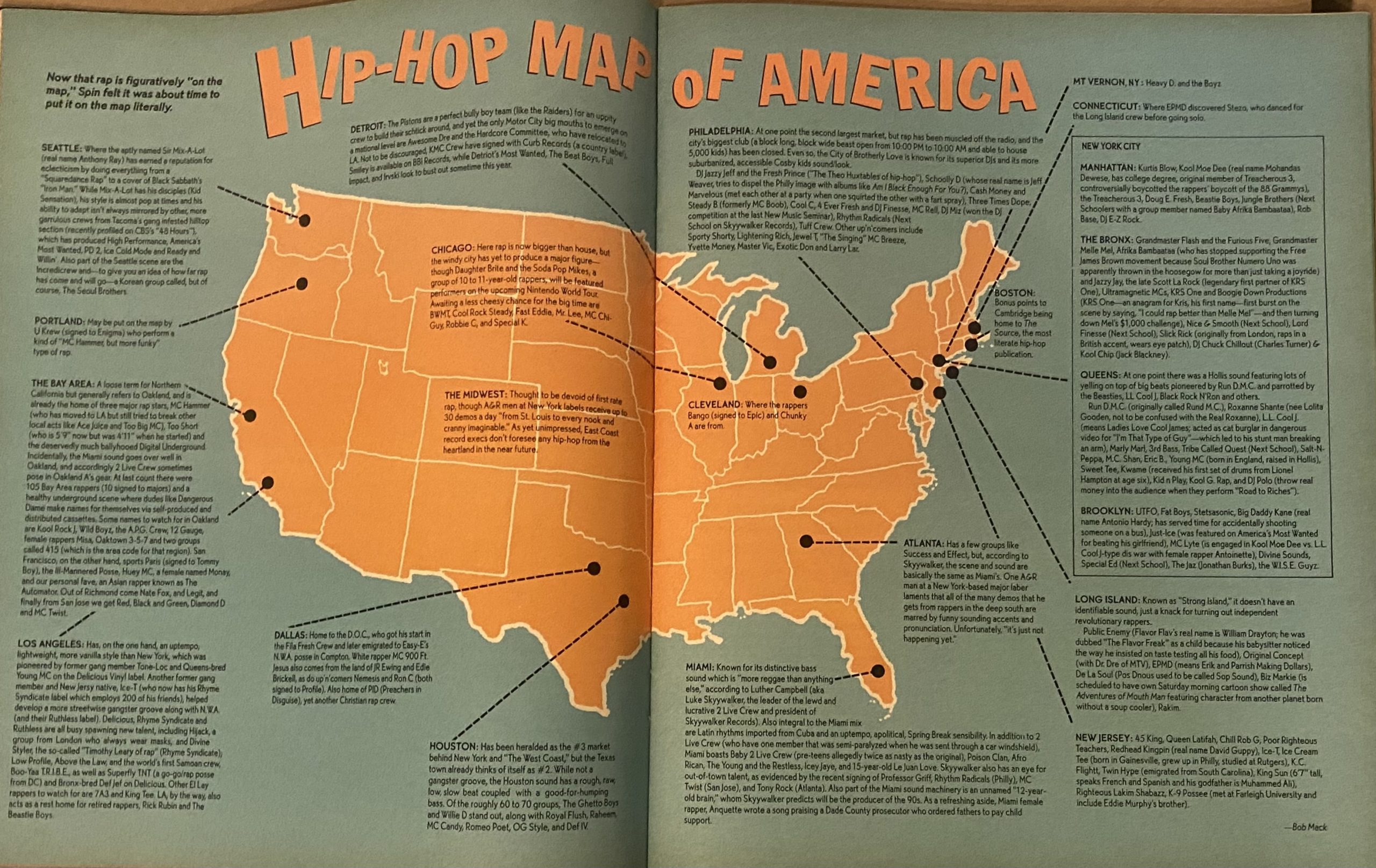By 1990, rap music had become more than a New York counterculture movement that funk acts and disco novelty performers alike viewed as a passing fancy. It had grown into a global trend, inspiring numerous local scenes at various stages of artistic development across the United States. The audience’s increasing awareness of the genre’s regional idiosyncrasies, from New York hardcore to Miami bass, and from West Coast reality rap to Chicago hip-house, gave rise to the concept of a “hip-hop nation” that persisted throughout much of the decade.

In the June 1990 issue of Spin magazine, journalist Bob Mack — best known for his association with the Beastie Boys — presented a “Hip-Hop Map of America.” It’s a snapshot that mostly builds around acts either signed to major labels or boasting national distribution. Cities without well-connected acts get cursory attention. Boston, for example, already boasted underground acts like Benzino’s The Almighty R.S.O., while Detroit rapper Esham had issued his debut album, Boomin “Words from Hell” 1990.
Meanwhile, Mack’s dismissal of Atlanta is off. Far from a useless backwater, it boasted New York transplant MC Shy D as well as Kilo Ali, Raheem the Dream, DJ Smurf, and future T.I. collaborator and trap pioneer DJ Toomp. “According to Skyywalker (Luke Campbell), the scene and sound is basically the same as Miami’s,” he writes. “One A&R man at a New York-based major label laments that all of the many demos that he gets from rappers in the deep south are marred by funny sounding accents and pronunciation.” It was elitist attitudes like this, casually expressed in putdowns like “funny sounding accents,” that would come back to haunt the East Coast rap industry by the end of the decade and beyond.
Today’s readers will find other details to quibble about. However, it’s worth noting that Mack created this map before the internet made it much easier to collate information about local scenes. Given his limitations, this cartography experiment is a useful albeit dated historical snapshot.

Five years later, Carter Harris, who followed his career in music journalism by writing and producing Hollywood movies and TV series like Friday Night Lights, published “Mapping the Hip-Hop Nation” in the May 1995 issue of Pulse! Accompanied by illustrator Lloyd Dangle’s quirky drawings, it struggles to encompass a complex and rapidly evolving genre. Houston’s DJ Screw doesn’t rate a mention at all, and neither does Port Arthur’s UGK. Some folks will laugh at the opinions expressed here. He mocks Houston’s 5th Ward Boyz as “mediocre,” and incorrectly describes Chicano duo N2Deep as “semi-funky white boys.”
But while the map wallows in familiar yet lovingly depicted stereotypes, from L.A. guns to Houston cars and liquor (drank?), this collection of “Regions to Believe” is stuffed with fun facts. It makes room for names that rarely show up in current discussions like Funky Aztecs (best known for making a track with 2Pac), D.C. Scorpio (who used the old hophead phrase “Beam Me Up, Scotty” in a rap song before D4L and Nicki Minaj), and Pistol (who released an album on Ruthless Records).
And if Atlanta got short shrift on Mack’s “Hip-Hop Map of America,” then circumstances had changed dramatically by the time Harris depicted the city. “A few years back, Atlanta’s musical doors were blown open with young pop-hop sensations Another Bad Creation, TLC and Kris Kross,” he writes. “With Erick Sermon, Too Short, Tupac and MC Breed all having moved here, this may well be the hip-hop mecca of the ’90s.”
Humthrush.com will always be free to read and enjoy. If you like my work, leave a tip at Ko-fi.com/humthrush.


